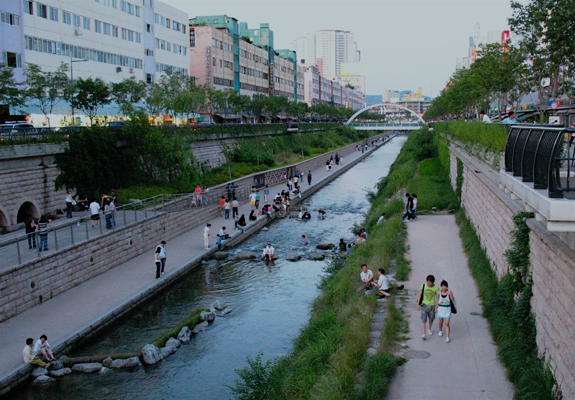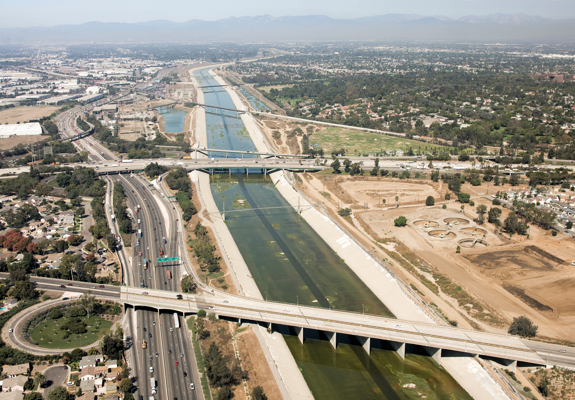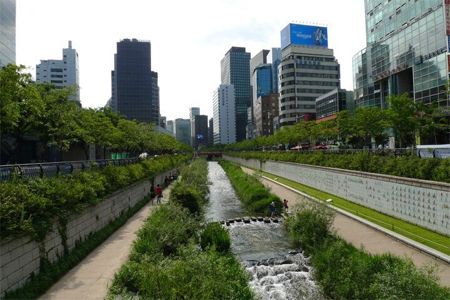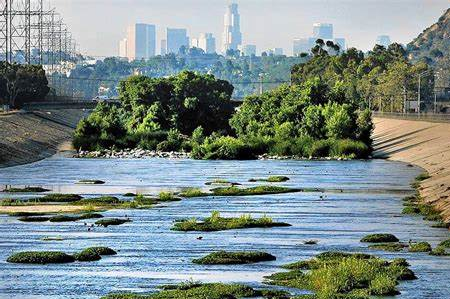
LA River vs Seoul’s Cheonggyecheon/Han River: How Urban Waterways Are Reshaping Cities
From concrete flood channels to vibrant ecological corridors, the Los Angeles River and Seoul’s Cheonggyecheon Stream/Han River restoration illustrate how urban rivers can catalyze environmental, social, and economic transformation. Once a free-flowing river sustaining Tongva communities, the LA River became a symbol of industrialization. After catastrophic floods in the 1930s, the U.S. Army Corps of Engineers encased 51 miles in concrete, prioritizing flood control over ecology. This infrastructure enabled LA’s growth but created a “gaping scar,” disproportionately affecting working-class neighborhoods. By the 1980s, activists like FoLAR began advocating for restoration, leading to the 2007 LA River Revitalization Master Plan, which aimed to reconnect communities, restore habitats, and create parks.
The Los Angeles River, spanning 51 miles through America's second-largest city, is dramatically transforming from a concrete channel to a potential ecological oasis. The river's revitalization aims to restore habitat, connect park-poor neighborhoods, and create a multi-purpose system that enhances urban life.
Seoul's Cheonggyecheon Stream represents a remarkable success story of urban river restoration. In just 29 months, the city transformed an elevated freeway into a 5.84-kilometer restored waterway that has become a vibrant public space.
Seoul’s Han River historically served as a trade route and defense barrier, while the Cheonggyecheon Stream became a polluted sewer buried under a highway post-Korean War. In 2003, Mayor Lee Myung-bak launched the Cheonggyecheon Restoration Project, removing the highway and restoring 3.6 miles of stream. The $384 million effort transformed it into a pedestrian-friendly green corridor, sparking economic revival. The Cheonggyecheon Stream restoration offers Los Angeles crucial lessons in urban river revitalization, demonstrating how strategic interventions can transform waterways into dynamic urban environments.
The Los Angeles River and Seoul's urban waterways represent contrasting approaches to river restoration and urban revitalization. They offer valuable lessons on how cities can transform waterways into environmental and economic renewal engines.
| Cheonggyecheon | LA River | |
 |
 |
|
| Length | 3.8 miles | 51 miles |
| Cost per Mile | $100M (total $380M) | $550K–$2.5M (variable by reach) |
| Funding Source | Centralized government (79% public approval) |
Federal grants, local bonds, private partnerships |
| Biodiversity | Steelhead trout reintroduction | 192 insect species vs. 15 pre-restoration |
| Economic Growth | $2.7B–$5.4B projected development | 6.3% rise in nearby property values |
| Community Access | 32-mile greenway in progress | 10.9 km of pedestrian paths |
Ecological Outcomes
The ecological transformations of Seoul’s Cheonggyecheon Stream and the Los Angeles River reveal contrasting paths in urban waterway restoration. Seoul’s 3.8-mile Cheonggyecheon achieved remarkable biodiversity gains post-restoration, with fish species surging from 4 to 25, bird populations expanding from 6 to 36, and insect diversity skyrocketing from 15 to 192 species. The project also reduced local summer temperatures by about 5°C through strategic green corridor design. In contrast, the LA River’s 51-mile watershed faces more complex ecological challenges, where early-stage efforts like the Elysian Valley restoration aim to replace concrete channels with native vegetation while maintaining critical flood control functions. This delicate balance has slowed measurable ecosystem recovery.
Urban Design Priorities
Urban design priorities further differentiate these projects. Cheonggyecheon’s pedestrian-centric approach integrated 22 bridges with subway links and rapid bus lanes, creating seamless transit connections that boosted nearby property values by 25-50%. Meanwhile, the LA River emphasizes incremental, community-sensitive upgrades, developing bike paths, pocket parks like the 42-acre Taylor Yard, and water reclamation infrastructure while actively mitigating gentrification risks through policies like affordable housing mandates.
Water Management
Water management strategies also diverge significantly. Seoul maintains Cheonggyecheon’s flow through a pumped system that circulates 120,000 tons daily from the Han River, paired with reinforced embankments designed for 200-year flood events. Conversely, the LA River initiative prioritizes restoring natural hydrological cycles, proposing concrete removal to enhance stormwater capture and aquifer recharge, which requires careful calibration to preserve flood protection for 4 million residents. These contrasting methods highlight how urban river revitalization adapts to local environmental constraints and community needs.
Scale as a Defining Factor in Urban River Revitalization
The disparity in length between Seoul’s 3.8-mile Cheonggyecheon Stream and the 51-mile Los Angeles River creates fundamentally different challenges and opportunities for urban renewal. This scale difference shapes funding mechanisms, ecological impact, and community engagement strategies, revealing why speed alone cannot measure success.
Seoul’s compact 3.8-mile Cheonggyecheon project benefited from centralized funding, with $380 million (90% of Seoul’s municipal budget) rapidly allocated due to its limited geographic scope. This concentrated effort minimized bureaucratic delays, enabling completion within 27 months. Conversely, the LA River’s 51-mile span across 33 jurisdictions relies on fragmented financing, including $28 million from federal infrastructure grants and Proposition 68 funds targeting underserved communities. While promoting equitable distribution, this decentralized funding structure necessitates phased implementation that extends timelines, a trade-off inherent to large-scale watershed revitalization efforts.
Integrated Governance and Phased Execution
The revitalization of the Los Angeles River exemplifies the complexities of large-scale urban renewal. Efforts prioritize balancing flood control mandates with ecological restoration and community needs, as seen in initiatives like the 2016 LA River Ecosystem Restoration Project, a multi-agency endeavor targeting 719 acres of habitat revival across 11 miles.
Recent milestones include the Reach 8A project near Downtown LA, which creates critical fish passages for endangered steelhead trout while maintaining flood capacity. Parallel investments in green equity, such as the 42-acre Taylor Yard park and expanding bike path networks, aim to address historical park disparities in working-class neighborhoods. However, these improvements risk accelerating gentrification, prompting safeguards like anti-displacement measures in the 2020 LA River Master Plan, which outlines 25-year goals for affordable housing integration and 51 miles of continuous trails.
In contrast, Seoul achieved rapid transformation in just 29 months through centralized political will, focusing first on public land and then leveraging private sector partnerships for adjacent development. Mayor Lee Myung-bak and a unified command structure (Cheonggyecheon Restoration Headquarters). The $384 million project removed an elevated highway to create a pedestrian-focused greenway, cooling adjacent areas by 3.3°C to 5.9°C (5.9°F to 10.6°F) compared to parallel roads 4–7 blocks away and boosting biodiversity by 639% through native plantings.
This catalytic intervention attracted 90,000 daily visitors, reduced air pollution by 35%, and stimulated $170 million in annual economic activity. Complementing this success, Seoul's Han River Renaissance developed 40 miles of recreational waterfronts, including cultural hubs like Yeouido Island, demonstrating how concentrated investments can reshape urban hydrology into economic and ecological assets. Where LA's incrementalism prioritizes equitable process, Seoul's model shows the power of bold, targeted interventions in dense urban cores.
Outcomes and Trade-Offs
Seoul’s concentrated investment delivered rapid environmental and economic returns, while LA’s distributed model emphasizes long-term equity—evident in its 2020 Master Plan’s 25-year affordable housing and trail goals. Both models highlight that scale dictates not just timelines but the very metrics of success: velocity versus inclusivity and concentrated impact versus systemic change.
| Cheonggyecheon | LA River | |
 |
 |
|
| Funding Efficiency | $100M/mile | $550K–$2.5M/mile |
| Community Impact | 25-50% property value rise | 42-acre Taylor Yard Park addressing park inequity |
| Challenges | Initial vendor displacement | Gentrification risks in Frogtown/Elysian Valley |
| Execution Speed | 29 months | 20+ year plan |
| Public Engagement | High (79% approval) | Mixed awareness |
| Primary Funding | Government ($384M) | Federal-local partnerships |
| Temperature Reduction | 5°C achieved | Climate resilience goal |
Seoul's Cheonggyecheon restoration demonstrates how integrated transportation planning can amplify urban river revitalization efforts. The project reduced traffic congestion by introducing 7.2 km of rapid bus lanes, expanding subway capacity by 33% through new rolling stock and frequency adjustments, and deploying intelligent transport systems to optimize delivery vehicle routes. This multimodal approach maintained mobility despite removing a significant highway. At the same time, LA could replicate similar synergies by aligning its river restoration with Metro’s Eastside Extension and establishing zero-emission freight corridors along industrial river zones.
Governance and Public Support
Seoul’s Cheonggyecheon succeeded through centralized leadership under Mayor Lee Myung-bak, who secured 79% public approval and streamlined decision-making via a dedicated restoration headquarters1. With $384 million in government funding, this top-down approach enabled rapid concrete-to-greenway conversion in 29 months.
Conversely, the LA River’s 51-mile span across 33 jurisdictions necessitates decentralized collaboration between federal agencies like the Army Corps of Engineers, municipal governments, and grassroots groups. This structure prioritizes community input but slows progress. While LA’s participatory process addresses gentrification concerns through measures like tenant purchase programs, fragmented authority complicates funding allocation and large-scale visioning.
| Seoul Approach | LA Adaptation | |
| Business Support | ₩20B ($15M) in vendor relocation aid | Expand LA's BusinessSource Centers for riverside SMEs |
| Anti-Gentrification | Voluntary renewal zones with tax incentives | Strengthen LA's Tenant Purchase Program near river sites |
| Value Capture | 25-50% property value increases fund community benefits | Apply LA's linkage fees to river-adjacent developments |
Challenges and Criticisms
The revitalization efforts of the Los Angeles River and Seoul’s Cheonggyecheon Stream face considerable challenges, particularly regarding gentrification, funding, and water management. In LA, river-adjacent neighborhoods like Elysian Valley and Frogtown confront displacement risks as property values rise alongside new green infrastructure projects, with studies showing increased housing insecurity in historically underserved communities.
While Seoul’s Cheonggyecheon initially sparked protests from displaced small businesses, many later capitalized on tourism growth—a nuanced outcome LA aims to replicate through policies like community benefits agreements and tenant protections. Scale and funding disparities further differentiate the projects: LA’s 51-mile revitalization requires $3 billion and decades to navigate complex governance across multiple municipalities. Seoul’s concentrated 3.8-mile Cheonggyecheon restoration cost $384 million and was finished in two years through centralized funding.
Water management strategies also diverge. LA relies on treated wastewater to maintain minimal river flow. At the same time, Seoul’s Cheonggyecheon employs a pumped system drawing 120,000 tons daily from the Han River, raising questions about long-term sustainability versus ecological restoration goals. These contrasts underscore the delicate balance cities must strike between rapid urban renewal and equitable, environmentally conscious development.
Lessons for Urban Revitalization
Seoul’s Cheonggyecheon restoration offers critical lessons for Los Angeles, particularly in addressing accessibility and community equity. The project initially overlooked universal access design features like elevators and wheelchair provisions, requiring costly retrofits after public backlash, a misstep LA could avoid by mandating accessibility standards in its ARBOR guidelines from the outset. Similarly, Seoul’s displacement of 62,000 street vendors sparked protests, underscoring the need for LA to expand its Community Benefits Agreement model to protect vulnerable businesses during river-adjacent developments.
While Seoul achieved rapid implementation through centralized leadership (Mayor Lee Myung-bak’s vision) and 79% public approval, LA’s decentralized governance prioritizes gradual, equity-focused engagement across diverse stakeholders. Both cities demonstrate innovative ecological strategies, merging flood control with habitat restoration—Seoul through terraced banks and LA via permeable pavement—highlighting how green infrastructure can serve dual urban needs. These contrasts reveal that successful river revitalization requires balancing bold leadership with inclusive design and proactive community safeguards.
The Future of Urban Rivers
The Cheonggyecheon experience proves river revitalization can drive environmental justice when paired with transit-oriented development and equitable economic policies. For LA, this means coupling ecosystem restoration with affordable housing mandates and workforce development programs tailored to riverside communities. Recent innovations like the LA River Master Plan's "Reach" segmentation show promising alignment with Seoul's zoned management strategies, creating a template for 21st-century urban waterway stewardship.
The LA River and Seoul’s waterways prove that even heavily engineered rivers can become catalysts for sustainable urbanism. While LA grapples with balancing revitalization and equity, Seoul offers a blueprint for rapid, community-focused transformation. As climate change intensifies, these projects highlight the urgency of rethinking urban waterways not as infrastructure but as lifelines connecting ecology, culture, and people.
Explore More